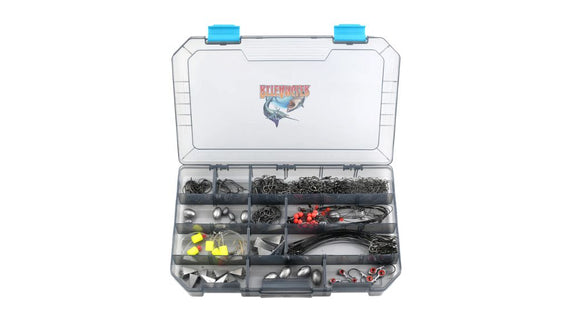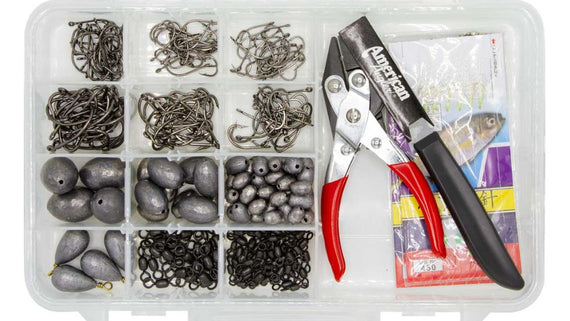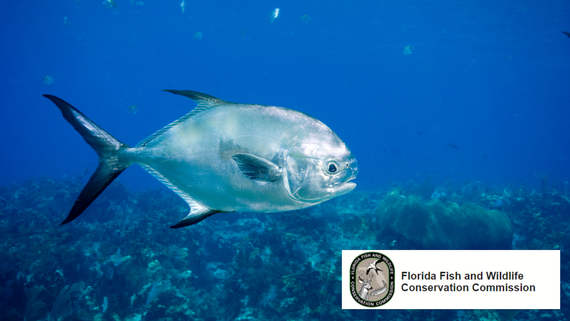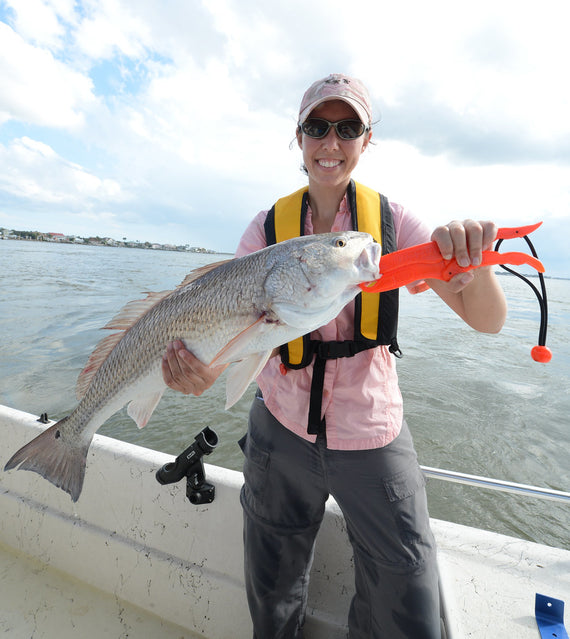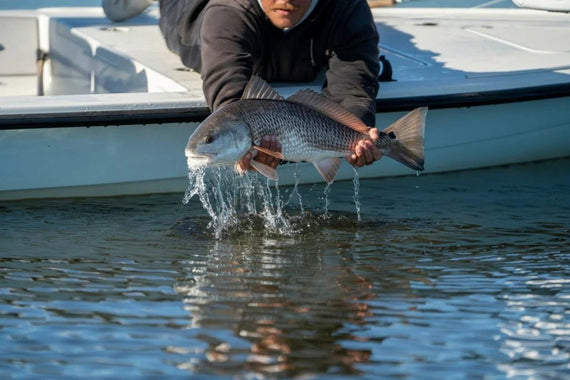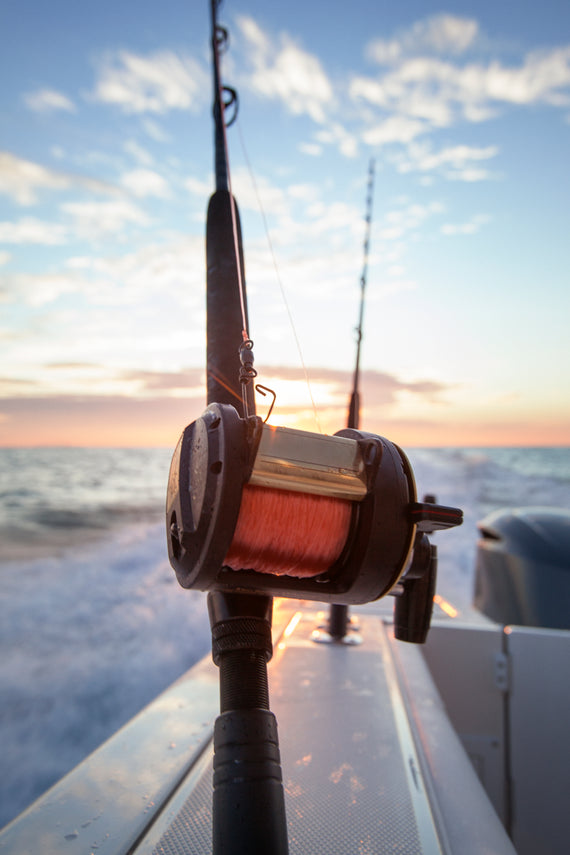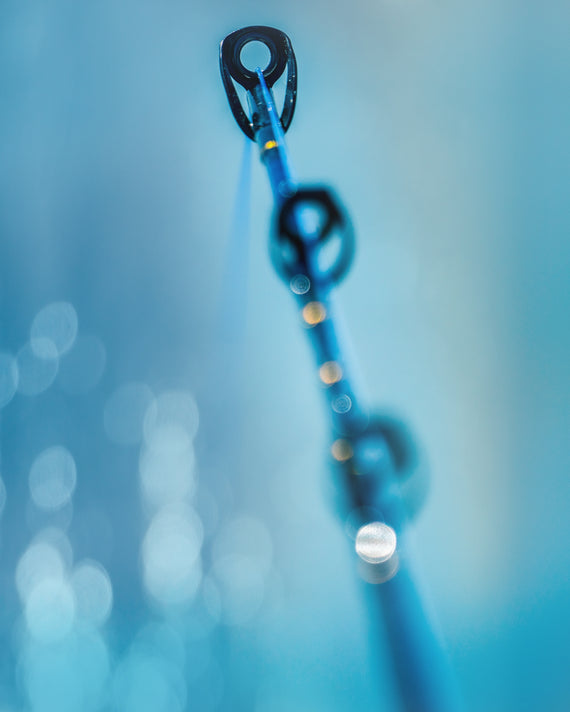-
![Top 10 Essential Fishing Gear and Equipment for Beginners]()
Top 10 Essential Fishing Gear and Equipment for Beginners
Whether for sport, recreation, or even dinner, fishing is a time-honored hobby for many. The thrill of reeling in a catch after hours of casting a line is a sensation some enthusiasts chase throughout their lives. If you’re new to the pastime, you may not know what to bring out onto the water with you. The proper fishing gear and equipment are the key to a successful haul and enhancing your overall experience. On that note, below is a comprehensive guide to assembling the best angling starter kit. Understanding Fishing Gear and Equipment These ten items are perhaps the most essential for a beginner fishing kit: Rod and reel Lines and Leaders Bait/lures Hooks Sinkers Bobbers Snap swivels Tacklebox Multi-tools Fishing license Each piece of equipment serves a unique function, so you’ll want to focus on quality over quantity. Cheap gear might seem budget-friendly but will likely cause headaches through poor results. The Ultimate Beginner Fishing Kit As bass are easier to locate, target, and catch than other fish in freshwater, the best beginner fishing gear to look for is bass fishing equipment. It consists of the following: Fishing Rod and Reel Combo The rod casts the line while the reel pulls it in. Combo packages with rod, reel, and line are perfect beginner fishing gear. Choose a quality rod about seven feet in length from these options: Spincast Reels Spincast reels use a button to release the line for simple casting. They’re not as strong or durable as other reels but are perfect for small fish. Baitcasting Reels While baitcasting reels offer excellent accuracy, they’re both difficult to use and expensive, making them best for experienced anglers only. Spinning Reels Spinning reels offer superior casting distance, control, durability, and strength over spincast reels, and they are easier to use and less expensive than baitcasting reels. Fishing Line Finding the best fishing equipment also means considering the strengths of each of the three main types of fishing lines: Monofilament Line Monofilament is easy to tie, inexpensive, durable, and offers good casting, but it’s stretchy, which limits feedback. Fluorocarbon Line With less stretch than monofilament, fluorocarbon offers better feedback and is invisible underwater. However, it’s more expensive and sinks quicker. Braided Line Braided line is strong, easy to cast, and has zero stretch, offering the greatest feedback. However, it’s expensive and slippery, making it hard to knot. Essential Fishing Equipment and Accessories Alongside your rod, reel, and line, you’ll need the following for your fishing adventures: Tacklebox Your tacklebox stores all of your fishing gear and accessories in distinct compartments. It ensures they don’t get lost and protects them from environmental hazards such as salt and moisture. Hooks and Weights Hooks come in various types and sizes you need to be aware of. Too big means the fish won’t get hooked, while too small means the fish will probably swallow the hook instead. Barbed hooks cause more damage, lower survival rates, and are hard to remove, making them perfect for catching fish you plan on eating. Weights/Sinkers and Bobbers Weights (also called sinkers) bring the hook down to the right depth. Without them, hooks would just float with the current. The most common types of these are as follows: Bell Weights: Excellent for placing bait deep in the water Bullet Sinkers: Best used in bass fishing, as they don’t get easily caught in vegetation Split Shot Sinkers: Allow for quick and easy tailoring to the exact weight you need on the line Egg Sinkers: Run through rocks and pebbles in deep water without catching Pyramid Sinkers: Cut into mud and sand to keep lines from moving Bobbers are the opposite of sinkers: They float at a determined depth to keep the hook from sinking to the bottom. Snap Swivels When a fish gets ahold of your hook, it will thrash and turn, which will twist your line, causing it to tangle, snag, or even snap. Snap swivels let the hook spin freely, keeping your line from twisting. Multi-tool Your multi-tool will bend hooks, cut lines, and remove hooks from freshly caught fish. Bait Worms can often be bought by the bucket, but you can collect them to save money. You can also use soft bait, which works well on shallow-water fish like catfish or crappie. It is soft plastic made to look like the kind of creatures fish enjoy, such as crawdads, smaller fish, and worms. Hard bait is made from sturdier materials such as wood, metal, or hard plastic. It can frequently be reused to catch larger, open-water fish such as pike or bass. Crankbait, a type of hard bait made to look like minnows, is an excellent option for beginners, as spinnerbait moves in a flowing action that easily fools fish. Bass Fishing Equipment for Beginners For new anglers looking to target bass specifically, you‘ll need the following: Rod: Start with a 7-foot medium-heavy rod Reel: Spinning reel Line: Monofilament Bait: Hard bait Weights: Bullet sinkers Start at a shallow part of a pond at sunrise. You’ll find smaller, easier-to-catch bass and take advantage of low-light conditions. Look for cover where the bass like to hide, such as fallen logs, grass, and lily pads. Make sure you move your bait in a lifelike motion and keep the bass above the water as you reel it in! Tips for Choosing the Best Starter Fishing Gear If you’re casting for smaller fish, you can pick up a cheaper, shorter rod and spincast reel for less than $100. However, if you’re serious about improving your skills and going after bass and several other kinds of fish, your shopping list of gear will be a little more substantial, looking something like this: Rod: At least $100 Reel: $50 Fishing License: Approximately $20 Monofilament Line: $25 Hard and Soft Bait Selection: $30 Hooks: $10 Weights: $10 Tacklebox: $30 Snap Swivel: $5 Multi-tool: $20 Altogether, that comes out to $300. Get Ready for Your Fishing Adventure You don’t have to spend much to set up a beginner fishing kit. It’s easy to find a rod and reel that will keep going for possibly hundreds of expeditions. If you still feel the choices and options are overwhelming, turn to Rite Angler! We’ve been supplying beginning and professional anglers since 1990 and will gladly steer you in the right direction! FAQs What Gear Does a Beginner Fisherman Need? Novice fishermen will need a rod between 6 and 7 feet, a spincast reel (or spinner reel for larger fish), a quality monofilament line, hooks, a selection of hard and soft bait, sinkers, a snap swivel, a tacklebox, and a multi-tool. What Is Included in a Beginner Fishing Kit? Beginner fishing kits typically include a basic rod with a spincast reel. They should also include monofilament lines, hooks, hard and soft bait, snap swivels, and tackle boxes. What Is the Simplest Fishing Setup? A rod with a spincast reel and monofilament line is often the easiest setup. The hook must be sized for the caught fish, but hard bait will allow first-time anglers to continually try again. What Fishing Rod Is Best for Beginners? A spincast reel/rod combo between 6 and 7 feet long is best for beginners. The handle should be cork or a composite material for a good grip. Fiberglass rods are a common choice, as they are inexpensive and flexible. Is It Better to Fish With a Pole or Rod and Reel? Unlike rods and reels, a pole will have its fishing line connected to the end directly, meaning the user has to pull it in by hand. Poles are simple and accurate but restrict the distance of casts. Rods cast farther and pull in larger fish but cost more and are more complex. What Is the Hardest Fish to Catch on a Rod? Wahoo, tarpon, and marlin are unbelievably strong and fast! You’ll need heavy-duty rods and reels, braided lines, strong muscles, and determination to catch such prized fish. What Length Rod for Beginners? Rods between 6 and 7 feet balance a shorter rod's control and a longer rod's casting distance. What Fishing Line Is Best for Beginners? Monofilament lines are cheap and easy to tie into knots. Fluorocarbon lines are stronger but pricier. Braided lines are more expensive and the hardest to tie. Still, if strength matters, a braided line is best. What Is the Best Starter Fishing Gear for Bass Fishing? The best starting gear for bass fishing consists of a 6—or 7-foot rod with a spinning reel, crankbaits and spinnerbaits, and hooks sized between 1 and 2 inches. Bullet weights will also help by avoiding snagging on vegetation where bass like to hide. How Do I Choose the Right Fishing Equipment? You should choose equipment based on your skill level, the type of fish you want to catch, and your fishing location. Six or seven-foot rods are best when fishing from a boat. Eight-to-fourteen-foot rods are good when shore fishing. Spincast reels are inexpensive and easy to use but only suitable for small fish. Spinner reels are stronger, smoother, and more durable, and baitcasting reels offer excellent control but are for experienced anglers. What Accessories Do I Need for Fishing? You’ll need a tacklebox, a variety of lures and hooks, spare lines, bobbers and sinkers, snap swivels, and multi-tools.Read more -
![Best Tackle Boxes for Fishing: A Guide]()
Best Tackle Boxes for Fishing: A Guide
How to Choose the Right Tackle for the Right Fish To catch fish, you need the proper combination of weather conditions, skills, expertise, and patience. Luck doesn’t hurt, either. However, to get a fish worthy of showing off, you will need the right equipment and tackle. Many fishermen rely on their tackle boxes to keep their gear safe and well-organized. The best fishing tackle will significantly improve your fishing experience. If you want to do serious fishing, the weight, materials, flexibility, and length of your rods must all be appropriate for the type of fishing you want. It's important to prioritize quality gear over cheap, flimsy materials. Instead of fishing for tackle that you hope will be good enough, let's take a look at the best tackle boxes for fishing that will guarantee a good catch. Why the Right Tackle Matters Choosing the correct tackle for your fishing trip can make all the difference in the world. Different fish species require distinct types of tackle, so it’s essential to have a variety of options in your tackle box for fishing. For example, if you plan on catching big game fish like marlin or tuna, you'll need sturdy rods and reels specifically designed for deep-sea fishing. On the other hand, if you're targeting smaller freshwater fish like trout or bass, you'll want lighter gear with more flexibility. Using proper equipment increases your chances of catching a specific type of fish and makes the whole experience more enjoyable. Imagine trying to catch a delicate trout with a heavy-duty saltwater rod – it's not likely to end well. Matching Tackle to Your Fishing Goals Fishing in different locations and bodies of water calls for different types of tackle. For instance, saltwater fishing demands equipment that can withstand the harsher conditions and larger fish found in the ocean. Freshwater fishing, on the other hand, may require more finesse since freshwater fish tend to be smaller and more delicate. In addition, deep-sea fishing needs specialized gear due to the depth of the water and the size of the fish. Tuna, marlin, and swordfish are just a few examples of big game fish that require heavy-duty rods and reels. Ultimately, your choice of tools should match your goals for each fishing trip—whether you’re catching a specific species or simply enjoying a day on the water. Hooks, Sinkers, and Lines The type of fish you're after, their size, and the environment all play a role in selecting the appropriate gear. Below is an overview of how different hooks, sinkers, and lines in our tackle kit are suited for various fishing needs. Hooks Hooks come in various sizes and designs, each tailored for specific fish species and conditions. Our tackle kit includes: Octopus Beak Hooks (#2, #1, 1/0): These hooks are known for their versatility and stronghold, making them ideal for small to medium-sized fish like trout or snapper. Their slightly curved shape helps secure bait while ensuring a solid hookset in the fish's mouth. O’Shaughnessy Hooks (2/0, 3/0, 5/0): These larger and more durable hooks are designed for catching bigger fish such as bass, grouper, or catfish. Their long shank provides extra strength when fighting aggressive, hard-pulling fish. When selecting hooks, it’s necessary to match the hook size to the bait and the fish you're targeting. Smaller hooks (#2 and #1) are better for lighter bait and smaller fish, while larger hooks (5/0) are suited for bigger bait and larger game fish. Sinkers Sinkers are used to weigh down bait and control its depth in the water, making them crucial for reaching the target zone where fish feed. Our kit provides: Bass Casting Lead (1 oz): These sinkers are excellent for casting longer distances and maintaining your bait at a consistent depth, making them ideal for bass fishing in freshwater lakes. Lead Egg Sinker: Egg sinkers are versatile and commonly used in both freshwater and saltwater environments. The assorted weights allow you to adjust your tackle to the water conditions and the target species. Heavier sinkers (1 oz and 2 oz) are great for deeper waters or strong currents, while lighter ones (1/8 oz, 1/4 oz) are better for shallow waters or when you need a more subtle presentation. The key to choosing the right sinker is understanding the water depth, current strength, and the species you're after. Heavier sinkers are suited for deep-water or fast-current fishing, while lighter sinkers are used in calmer, shallower areas. Lines Fishing lines need to be durable, flexible, and strong enough to handle the fish you’re targeting. For smaller species, a light line of 6-8 lbs test may suffice, but for larger fish, a heavier line of 20-30 lbs test or even braided lines are recommended for extra strength and abrasion resistance. Tips for Choosing Reliable Equipment Before you head out in the water, you must be able to bring reliable tools that will make your fishing experience worry-free. Here are a few strategies to keep in mind: Durability: Always opt for corrosion-resistant materials, especially for saltwater fishing, where exposure to harsh environments can wear down your gear. Our hooks and sinkers are designed to withstand these conditions, providing long-lasting reliability. Comfort and Precision: Use the multi-tool plier for quick adjustments and the bait knife for efficient preparation. Both tools have cushioned handles for enhanced comfort, especially during long fishing trips. Bait Rigs: Our Sabiki Bait Rigs are perfect for catching baitfish and are essential for targeting larger species. These pre-tied rigs save time and make the process more efficient. By selecting the right combination of hooks, sinkers, and lines, you can tailor your tackle to specific fish species and fishing conditions, ensuring a more prosperous and enjoyable experience on the water. The Best Fishing Tackle Box for Saltwater Fishing It can be overwhelming to walk into a tackle shop or search for the best tacklebox online. There are so many different varieties of bait and lures to choose from that it gets tough to understand. After all, after a certain point, what’s the difference between them? Today, the daunting task of searching for the right tackle is over! Our reliable and trusted tackle box will be everything you need to catch your best fish, keeping all your gear organized, secure, and easy to access for a smooth fishing experience. Let’s take a closer look at what’s inside our complete tackle kit. Complete Tackle Kit Rite Angler provides a comprehensive tackle kit tailored for various types of saltwater fishing. Save time by avoiding the hassle of assembling your tackle supplies; everything you need is included in this complete tackle kit. Smart Divider System: This tackle box features adjustable dividers, allowing you to organize your gear efficiently and customize your storage to meet your needs. Anti-Corrosion Technology: An exclusive solution emits a corrosion-inhibiting vapor from the dividers, forming a protective layer on metal surfaces to prevent rust in harsh sea environments. Easy Identification Design: The translucent plastic lid and base allow you to see the contents even when closed. It is designed for anglers to facilitate quick and efficient baiting. Secured: A robust latching system ensures the box remains securely closed in rough waters. Our complete tackle kit includes: 1 Multi-tool Plier with cushioned plastic-dipped handles for comfort 1 Bait Knife 2 Sabiki Bait Rigs to kickstart your baitfish collection 25 Each: #2, #1 & 1/0 Octopus Beak Hooks 25 Each: 2/0, 3/0, 5/0 O’ Shaughnessy Hooks 4, 1 oz Bass Casting Leads 10 Each: 1/8 & 1/4 oz Egg Sinkers 5 Each: 1/2, 1, 2 oz Egg Sinkers 25 Each: #7, #5, #1 Barrel Swivels We also offer small and large tackle kits to suit your specific needs. All of our high-quality tackle, kits, and accessories are available online. Best of all, we’ll help guide you in selecting the right tackle for the fish you're targeting! Order the Best Fishing Tackle Box Online At Rite Angler, we take great pride in carefully curating a collection of lures, lines, and tackle designed to endure the harshest conditions—from the blazing sun and turbulent waves to the fierce challenges posed by deep-water creatures. Our products are crafted for anglers who demand durability and performance in the toughest environments. Our team is dedicated to discovering innovative products to enhance our offerings continuously. We strive to provide our customers with the ultimate fishing experience that marries quality, reliability, and thrill. So, if you are tired of fishing for tackle, choose Rite Angler and pick up the best tackle boxes for fishing. Order today and enjoy free shipping on all purchases over $49. With Rite Angler, you're not just buying gear but investing in unforgettable fishing adventures.Read more -
![Why Do I Need a Fishing license?]()
Why Do I Need a Fishing license?
Going out fishing is an amazing way to spend a peaceful day alone or an engaging day with your family or friends. But no matter if you’re catch and release fishing, or looking to fill the cooler with “meat,” chances are you’ll need a fishing license to fully enjoy your time.Read more -
![How to Catch Redfish From a Pier | Tips and Tricks]()
How to Catch Redfish From a Pier
Do you want to know some of the best tips and tricks on how to catch redfish from a pier? There is no other fish like the redfish, and when you land a good one, you’ll be thrilled beyond words. The smell of the sea and the satisfaction of reeling in a big catch is unlike anything else in the world.Read more -
![Best Tackle for Redfish | Buyers Guide]()
Best Tackle for Redfish
Often an exercise in futility, successful redfish fishing depends on a small but varied tackle selection. Commonly caught in the 4 to 6-pound range, red drums or “redfish” vary from rats of 15 inches or less to the greater-sized bull redfish that can exceed sixty inches in length and weigh a staggering ninety pounds. Redfish have an “inferior” mouth, meaning their nose extends out over the mouth. Reds typically use their hard nose to root around at the bottom of the water column. These fish are opportunistic feeders, not scavengers. It is a challenge for any expert to determine the best tackle for redfish since they can be so picky on any given day. The gear you should use will depend on where you want to fish and the size of fish you anticipate catching… and how the fish are reacting that day. Best Rods and Reels for Redfish Most anglers will target reds in the 3 to 10-pound range. For this type of red drum, medium spinning and light conventional setups work the best. Alternatively, those fishing for larger bull redfish in inlets and around bridges might be better suited using stout, conventional gear. Medium spinning rods with fast action with a 3000 or 4000 series reel work incredibly well for anglers explicitly targeting redfish. Fast-action in this scenario refers to a stout rod at the butt and middle with tapering for a limber tip. As one of the best rigs for pier fishing and other inshore situations, this outfit enables a fisherman to cast light lures and baits while maintaining appropriate strength to handle decent-sized fish. Like we said, they can grow huge. Some will utilize spinning rods when fishing with lighter lures and live bait. This setup is more appropriate when fishing redfish sized thirty inches and under in open water. Choosing a Fishing Line Option Modern saltwater fishing gear providers offer three basic choices regarding fishing lines for redfish outfits. These include fluorocarbon lines, braided lines and monofilament lines. Using a braided line remains the more popular choice. It is more expensive but doesn’t stretch, offers increased sensitivity, casts further, and lasts longer. A few feet of fluoro or mono leader should be used to help hide the line from the fish's sight. Some anglers prefer the stretch and feel of the monofilament line. Although braided line may remain more popular among redfish anglers, there is no end-all best tackle for redfish. It all comes down to a matter of individual preference. Pair this with one of our redfish rigs for pier fishing, and any angler is bound to reel in some nice reds. Top Artificial Lures Both live bait and artificial lures work great when targeting redfish. The main advantage of lures over traditional live bait is fishermen can use lures to cover more water while they search for fish. Some reddish may scatter out on larger, more expansive flats, making lures the better tackle solution. A tried-and-true lure option, the spoon may very well represent the top artificial redfish lure of all time. Weedless spoons help prevent the lures from getting caught in grass flats and still serve as one of the best search baits, enabling anglers to cover a significant distance safely. Plastic, tailed jigs are one of the oldest swimming bait options and are notably effective for catching various fish species. Red drums are no exception to the allure of these artificial baits. A simple, economical, effective option, soft plastic baits come in a wide array of colors and styles. Nonetheless, lighter colors work best in clear water for catching reds, and darker colors are a better solution for murkier conditions. Top Tackle Solutions for Catching Redfish Anglers have several choices at their disposal when attempting to fill a cooler to the brim with redfish. The best tackle for redfish will vary depending on the location, tide, temperature, time of year, and other factors. Rite Angler has some of the all-time best saltwater fishing gear for catching reds. With Rite Angler you have so much at your disposal that you can try. Once you figure out what works best to catch redfish, you should have a few rigs and lures that you can return to get them repeatedly. Always try varied fishing techniques, as variety is crucial to catching any fish. Our team from Rite Angler focuses on creating durable, corrosion-resistant fishing gear for the angler who understands the importance of quality fishing tackle. To learn more about what we can do to help you start catching reds (or any fish of your choice) in no time, reach out to Rite Angler today!Read more -
![12 Saltwater Fishing Tips for Beginners]()
12 Saltwater Fishing Tips for Beginners
Have you wanted to try saltwater fishing but don't know where to begin? Here are 12 saltwater fishing tips for beginners.Read more -
![Saltwater Fishing Essentials | Gear]()
Saltwater Fishing Essentials
Preparing for your saltwater fishing trip can be a little overwhelming, but being prepared is essential for a successful and satisfying day out on the sea. You've probably thought of shiny saltwater lures but may be unsure what the best saltwater fishing hooks are. If you've been looking for a comprehensive list of essentials for your fishing expedition, look no further.Read more















